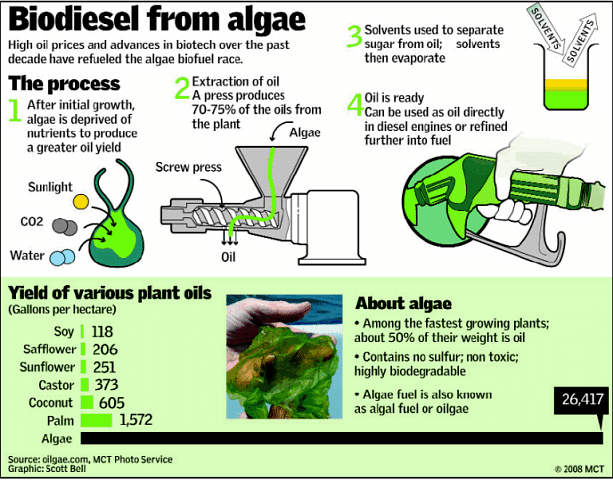
Recently, Hon`ble Union Minister for Petroleum and Natural Gas, Shri Dharmendra Pradhan emphasized the need of the natural gas and the Biofuel. Biofuel are the need of the hour. Earlier it was discussed that the Jatropha is the main source of biofuel hence scientists and researchers were looking for alternate source of energy through various available materials. Such a material is - Algae which is common in the ponds and water bodies. Akanksha Agarwal, a Research Scholar at DBT-ICT Centre for Energy Biosciences at the Institute of Chemical Technology, Mumbai has written a paper on the availability of biofuel from the Algae.
How scientifically, the Hydrothermal liquefaction of macro-algae Enteromorpha prolifera to bio-oil is possible shown in the Figure 1 and the research was conducted by Zhou, D., Zhang, L., Zhang, S., Fu, H., & Chen, J. The twenty first century scientists are becoming increasingly concerned about global warming and negative impacts of conventional sources of energy. There are various renewable energy sources that have emerged as a reliable source of power. In this energy crisis, emerges another new lucrative alternative; sometimes smelly but overflowing with potential – Algae.
That green scum floating on water is composed of unicellular photosynthetic micro-organisms performing wonders despite not in the limelight. While we sit basking in the sun, these tiny heroes are fixing photons to convert it into energy. More so, they are busy absorbing the carbon dioxide and convert them into the vital oxygen. Good things come in small packages indeed.
The real lure is the ability of microalgae to bio-convert atmospheric carbon dioxide into fuel. With the alarming rise in environmental pollution, a carbon-neutral energy source to power our engines is essential. Microalgae assimilate carbon to produce oil as energy storage within the cell. This oil content can amount to 50 percent of the cell weight, making the overall yield of oil form algae much higher (10-100 times) when compared to competing energy crops.
Further these microorganisms can grow practically anywhere; from open ponds in non-arable regions to a bucket in your backyard! Thus, algal oil poses no threat in the food vs. fuel debate. They could be the only feedstock with a potential to entirely replace fossil fuels. Through the process of producing oils, algae can simultaneously help us reduce our green house gases making algal fuel carbon neutral. Economically, algae-based fuels make all countries equally competitive on global scale and will help governments reduce oil imports, thereby saving resources within the nation for improving the standard of living.
Today, advanced technology has enabled us to convert this oil from algae into fuel for vehicles. In fact, this technology is already proven with eco-friendly buses running on microalgae fuel being implemented by a Japanese company Euglena Co. Ltd. in partnership with Isuzu Motors. Their next milestone is to fuel the transport for the Tokyo 2020 Olympics. Another remarkable milestone for the algal industry was the first algae fuel-powered passenger plane taking off from Chicago to Houston in 2011.
Research on fuel from algae is at the forefront in India with some corporate giants and research institutes experimenting with this new age fuel:
-
In 2015, Reliance Industries in partnership with Algenol, deployed India’s first Algenol algae production platform near the Reliance Jamnagar Refinery in Gujarat.
-
The Indian Oil Corporation has signed an agreement with Petro Algae to license technology for the large-scale production of biofuel from microalgae.
-
Aban Infrastructure Pvt. Ltd. is another biotech company based in Chennai which has developed low-cost commercial scale open ponds for algal biomass cultivation specifically for biofuels and bioremediation.
-
Clean Environment Technology Pvt. Ltd is in the domain of wastewater treatment using microalgae and biomass conversion to biofuels. Their commercial plant is due to be set up in Uttar Pradesh soon.
-
Sea6 Energy is another big success in the algal story with their seaweed cultivation for biofuels. Algae Biotech India Pvt Ltd is another player in the microalgae for nutraceuticals and renewable energy sector.

Further, state-of-the-art infrastructure is being set up in many national labs such as the Indian Institute of Technology Bombay, IIT-Roorkee, TERI, ICGEB and many more. Meanwhile, Centre for Jatropha Promotion & Biodiesel has undertaken field trials of micro-algal cultivation in open ponds and photo-bioreactors in Rajasthan. The scientific community is optimistic that these pilot projects pave the path for commercializing various algal technologies in near future.
Ira A. Levine, an algal expert from the University of Southern Maine, US feels India can play a major role in algal farming and can become a world leader in this sector powered by its wealth of diverse freshwater and marine algae, including seaweeds. The scope of investing in algal research is promising because algae can produce between 7,500 and 19,000 litres of fuel per acre, far more than any other renewable feedstock.
So why has all this excitement about algae not produced tangible products in the market? While the science is mature, the major roadblock comes in terms of the money involved. The current cost of algal fuel is approximately INR450/litre, while petrol is available at one-sixth of the price. Algal fuels thus require a drastic reduction in production cost to compete in the market. While it may seem that the future for algal fuels is a long shot, there are some remarkable success stories in the journey of algae for fuels; from making cheap cultivating media to genetically engineering these bio-factories to give high yields.
For example, shale gas was quite expensive in its early stages but with determination of corporations and scientists, it now competes directly with conventional oil. Hence despite the roadblocks we see in commercialization today, with our technological prowess, it is very possible that the next car you purchase would run with a green fuel tank! A future that witnesses the scaling of algae is sure to be a very green future!
Green tides are overgrowths of algae that occur in response to many factors, including excess nutrients in marine water. Up to 10^66 tons of a particular algae, E. prolifera, can be collected from a single green tide event. Rather than waste this biomass, researchers attempt to convert the algae into a renewable source of fuel called bio-oil using a process known as hydrothermal liquefaction (HTL). In HTL, water is added to dried algae; the mixture brought to sufficiently elevated temperature and pressure conditions to allow the water to decompose the algal biomass. After the reaction mixture is cooled, it can be separated according to the scheme shown in Figure
Analysis of the bio-oil indicate that it is composed of over 180 compounds. The top five most common constituent molecules are shown below.
|
Compound |
Name |
Formula |
|
1 |
hexadecanoic acid |
CH_33(CH_22)_{13}13COOH |
|
2 |
oleic acid |
CH_33(CH_22)_77CHCH(CH_22)_77COOH |
|
3 |
2-methyl-2-cyclopenten-1-one |
C_66H_88O |
|
4 |
3-methyl-2-cyclopenten-1-one |
C_66H_88O |
|
5 |
2,3-dimethyl-2-cyclopenten-1-one |
C_77H_{10}10O |
Adapted from: Zhou, D., Zhang, L., Zhang, S., Fu, H., & Chen, J. Hydrothermal liquefaction of macroalgae Enteromorpha prolifera to bio-oil. Energy & Fuels, 24(7), 4054-4061; Zhou, D., Zhang, S., Fu, H., & Chen, J.). Liquefaction of macroalgae Enteromorpha prolifera in sub-/supercritical alcohols: direct production of ester compounds. Energy & Fuels, 26(4), 2342-2351.
The researchers could have used many solvents in extracting the oil from the aqueous reaction mixture. What characteristic of CH_22Cl_22 makes it a better solvent than hexane for this procedure?










